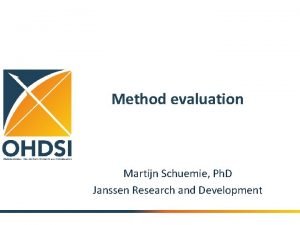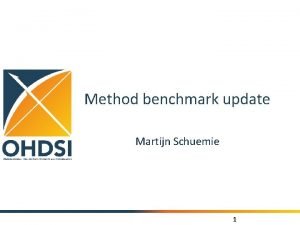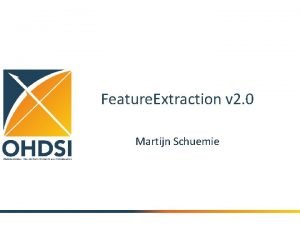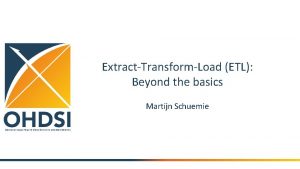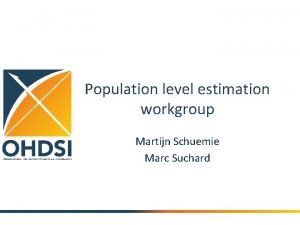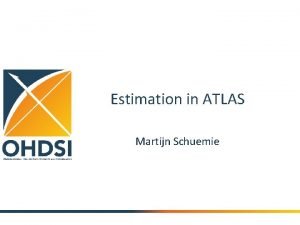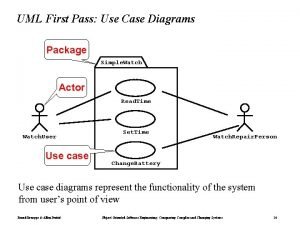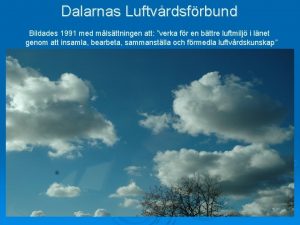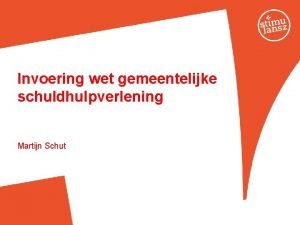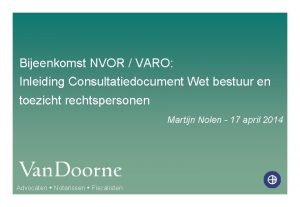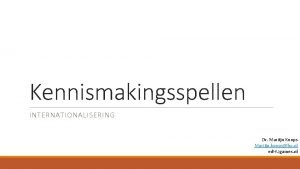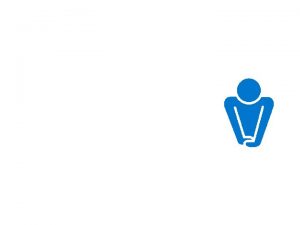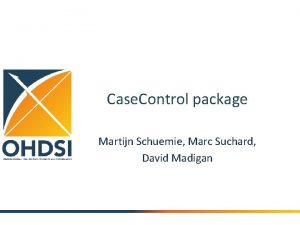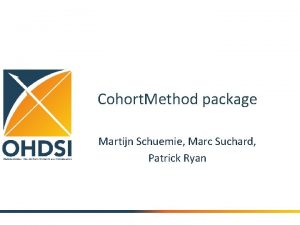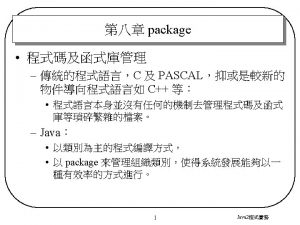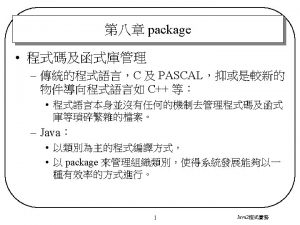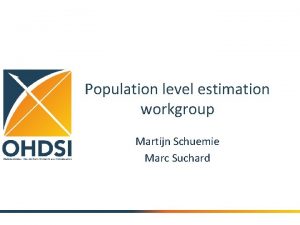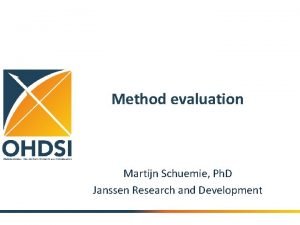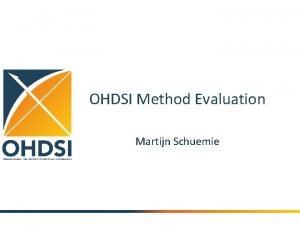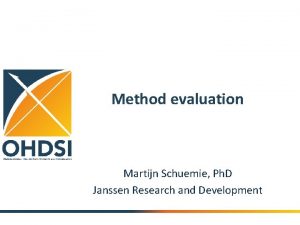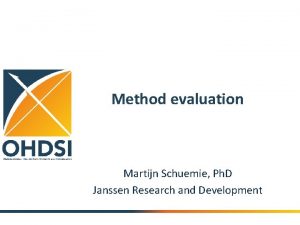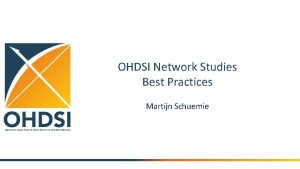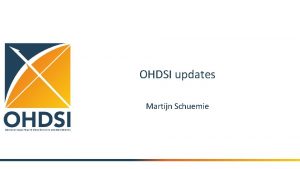Self Controlled Case Series package Martijn Schuemie Marc



























- Slides: 27

Self. Controlled. Case. Series package Martijn Schuemie, Marc Suchard, Patrick Ryan

Quick recap of previous meeting • We discussed the Cohort. Method package – Large scale regression propensity models – Large scale regression outcome models – Using negative controls, we see a reduction in residual bias when using PS matching + full outcome model • Interest to learn about the other methods packages as well

Self-Controlled Case Series Is the outcome more likely during exposed time compared to nonexposed time? Outcome Patient A Exposure Outcome Patient B Exposure Outcome Patient C Exposure 3

Self-Controlled Case Series Given that a patient has the outcome, is the outcome more likely during exposed time compared to non-exposed time? Conditioning on the outcome helps: Outcome - Insensitive to differences between subjects that are constant over time - Only require data on subjects with the outcome Patient A Exposure Outcome Patient B Exposure Biggest problem left: correct for time-varying. Outcome confounding Patient C Exposure 4

Correcting for age and season SCCS can be confounded if • prevalence of both the drug and the outcome change with age • prevalence of both the drug and the outcome vary by season

Correcting for age and season Solution: include age and season in the model: Outcome Exposure Februari January interval 1 interval 2 interval 3 March interval 4 Lots of parameters to estimate! interval 5

Correcting for age and season Rate Solution: use splines (assume effect constant within calendar month) 1 2 3 4 5 6 7 Month 8 9 10 11 12

Contra-indication tends to bias to higher estimates GI Bleed Pre-exposure NSAID Risk Apparent relative risk is higher Baseline Apparent Baseline Increased risk due to NSAID Decreased risk because GI Bleed would have prevented prescription

Event-dependent censoring If the outcome increases the probability of censoring, this can lead to bias Myocardial Infarction Vioxx Solution: reweigh time at risk Stolen (with permission) from R package by • Yonas Ghebremichael-Weldeselassie • Heather Whitaker • Paddy Farrington (Re-implemented in C++ for speed)

Other exposures Opioid Antibiotic Oral contraceptive PPI NSAID • Select additional drugs of interest, or • Throw in all other drugs (MSCCS) Antibiotic Statin GI Bleed

A single SCCS study sccs. Data <- get. Db. Sccs. Data(connection. Details, cdm. Database. Schema = cdm. Schema, outcome. Table = " cohort ", outcome. Ids = 1, exposure. Ids = c()) covar. Diclofenac <- create. Covariate. Settings(label = "Exposure of interest", include. Covariate. Ids = 1124300, start = 0, end = 0, add. Exposed. Days. To. End = TRUE) covar. Pre. Diclofenac <- create. Covariate. Settings(label = "Pre-exposure", include. Covariate. Ids = diclofenac, start = -60, end = -1) covar. All. Drugs <- create. Covariate. Settings(label = "Other exposures", exclude. Covariate. Ids = 1124300, stratify. By. Id = TRUE, start = 1, end = 0, add. Exposed. Days. To. End = TRUE, allow. Regularization = TRUE) age. Settings <- create. Age. Settings(include. Age = TRUE, age. Knots = 5) seasonality. Settings <- create. Seasonality. Settings(include. Seasonality = TRUE, season. Knots = 5) sccs. Era. Data <- create. Sccs. Era. Data(sccs. Data, naive. Period = 180, first. Outcome. Only = FALSE, covariate. Settings = list(covar. Diclofenac, covar. Pre. Diclofenac, covar. All. Drugs), age. Settings = age. Settings, seasonality. Settings = seasonality. Settings, event. Dependent. Observation = TRUE) control <- create. Control(cv. Type = "auto", selector. Type = "by. Pid", starting. Variance = 0. 1, threads = 30) model <- fit. Sccs. Model(sccs. Era. Data, control = control)

A single SCCS study sccs. Data <- get. Db. Sccs. Data(connection. Details, cdm. Database. Schema = cdm. Schema, outcome. Table = " cohort ", outcome. Ids = 1, exposure. Ids = c()) covar. Diclofenac <- create. Covariate. Settings(label = "Exposure of interest", include. Covariate. Ids = 1124300, start = 0, end = 0, add. Exposed. Days. To. End = TRUE) covar. Pre. Diclofenac <- create. Covariate. Settings(label = "Pre-exposure", include. Covariate. Ids = diclofenac, start = -60, end = -1) covar. All. Drugs <- create. Covariate. Settings(label = "Other exposures", exclude. Covariate. Ids = 1124300, stratify. By. Id = TRUE, start = 1, end = 0, add. Exposed. Days. To. End = TRUE, allow. Regularization = TRUE) age. Settings <- create. Age. Settings(include. Age = TRUE, age. Knots = 5) seasonality. Settings <- create. Seasonality. Settings(include. Seasonality = TRUE, season. Knots = 5) sccs. Era. Data <- create. Sccs. Era. Data(sccs. Data, naive. Period = 180, first. Outcome. Only = FALSE, covariate. Settings = list(covar. Diclofenac, covar. Pre. Diclofenac, covar. All. Drugs), age. Settings = age. Settings, seasonality. Settings = seasonality. Settings, event. Dependent. Observation = TRUE) control <- create. Control(cv. Type = "auto", selector. Type = "by. Pid", starting. Variance = 0. 1, threads = 30) model <- fit. Sccs. Model(sccs. Era. Data, control = control) Get all the data from the CDM database: - Specified 1 outcome in the cohort table - No exposure table specified: drug_era - No exposure IDs: include all exposures in drug_era - Get the data ‘as is’

A single SCCS study sccs. Data <- get. Db. Sccs. Data(connection. Details, cdm. Database. Schema = cdm. Schema, outcome. Table = " cohort ", outcome. Ids = 1, exposure. Ids = c()) covar. Diclofenac <- create. Covariate. Settings(label = "Exposure of interest", include. Covariate. Ids = 1124300, start = 0, end = 0, add. Exposed. Days. To. End = TRUE) covar. Pre. Diclofenac <- create. Covariate. Settings(label = "Pre-exposure", include. Covariate. Ids = diclofenac, start = -60, end = -1) covar. All. Drugs <- create. Covariate. Settings(label = "Other exposures", exclude. Covariate. Ids = 1124300, stratify. By. Id = TRUE, start = 1, end = 0, add. Exposed. Days. To. End = TRUE, allow. Regularization = TRUE) age. Settings <- create. Age. Settings(include. Age = TRUE, age. Knots = 5) seasonality. Settings <- create. Seasonality. Settings(include. Seasonality = TRUE, season. Knots = 5) sccs. Era. Data <- create. Sccs. Era. Data(sccs. Data, naive. Period = 180, first. Outcome. Only = FALSE, covariate. Settings = list(covar. Diclofenac, covar. Pre. Diclofenac, covar. All. Drugs), age. Settings = age. Settings, seasonality. Settings = seasonality. Settings, event. Dependent. Observation = TRUE) control <- create. Control(cv. Type = "auto", selector. Type = "by. Pid", starting. Variance = 0. 1, threads = 30) model <- fit. Sccs. Model(sccs. Era. Data, control = control) Specify an exposure-based covariate • Concept ID 1124300 (Diclofenac) • Risk starts at start of exposure • Risk ends at end of exposure

A single SCCS study sccs. Data <- get. Db. Sccs. Data(connection. Details, cdm. Database. Schema = cdm. Schema, outcome. Table = " cohort ", outcome. Ids = 1, exposure. Ids = c()) covar. Diclofenac <- create. Covariate. Settings(label = "Exposure of interest", include. Covariate. Ids = 1124300, start = 0, end = 0, add. Exposed. Days. To. End = TRUE) covar. Pre. Diclofenac <- create. Covariate. Settings(label = "Pre-exposure", include. Covariate. Ids = diclofenac, start = -60, end = -1) covar. All. Drugs <- create. Covariate. Settings(label = "Other exposures", exclude. Covariate. Ids = 1124300, stratify. By. Id = TRUE, start = 1, end = 0, add. Exposed. Days. To. End = TRUE, allow. Regularization = TRUE) age. Settings <- create. Age. Settings(include. Age = TRUE, age. Knots = 5) seasonality. Settings <- create. Seasonality. Settings(include. Seasonality = TRUE, season. Knots = 5) sccs. Era. Data <- create. Sccs. Era. Data(sccs. Data, naive. Period = 180, first. Outcome. Only = FALSE, covariate. Settings = list(covar. Diclofenac, covar. Pre. Diclofenac, covar. All. Drugs), age. Settings = age. Settings, seasonality. Settings = seasonality. Settings, event. Dependent. Observation = TRUE) control <- create. Control(cv. Type = "auto", selector. Type = "by. Pid", starting. Variance = 0. 1, threads = 30) model <- fit. Sccs. Model(sccs. Era. Data, control = control) Specify another exposure-based covariate • Concept ID 1124300 (Diclofenac) • Risk starts 60 days before start of exposure • Risk ends 1 day before start of exposure

A single SCCS study sccs. Data <- get. Db. Sccs. Data(connection. Details, cdm. Database. Schema = cdm. Schema, outcome. Table = " cohort ", outcome. Ids = 1, exposure. Ids = c()) covar. Diclofenac <- create. Covariate. Settings(label = "Exposure of interest", include. Covariate. Ids = 1124300, start = 0, end = 0, add. Exposed. Days. To. End = TRUE) covar. Pre. Diclofenac <- create. Covariate. Settings(label = "Pre-exposure", include. Covariate. Ids = diclofenac, start = -60, end = -1) covar. All. Drugs <- create. Covariate. Settings(label = "Other exposures", exclude. Covariate. Ids = 1124300, stratify. By. Id = TRUE, start = 1, end = 0, add. Exposed. Days. To. End = TRUE, allow. Regularization = TRUE) age. Settings <- create. Age. Settings(include. Age = TRUE, age. Knots = 5) seasonality. Settings <- create. Seasonality. Settings(include. Seasonality = TRUE, season. Knots = 5) sccs. Era. Data <- create. Sccs. Era. Data(sccs. Data, naive. Period = 180, first. Outcome. Only = FALSE, covariate. Settings = list(covar. Diclofenac, covar. Pre. Diclofenac, covar. All. Drugs), age. Settings = age. Settings, seasonality. Settings = seasonality. Settings, event. Dependent. Observation = TRUE) control <- create. Control(cv. Type = "auto", selector. Type = "by. Pid", starting. Variance = 0. 1, threads = 30) model <- fit. Sccs. Model(sccs. Era. Data, control = control) Specify other exposure-based covariates • All concepts except 1124300 • Risk starts 1 day after start of exposure • Risk ends at end of exposure • Create 1 covariate per concept ID • Allow regularization for these covariates

A single SCCS study sccs. Data <- get. Db. Sccs. Data(connection. Details, cdm. Database. Schema = cdm. Schema, outcome. Table = " cohort ", outcome. Ids = 1, exposure. Ids = c()) covar. Diclofenac <- create. Covariate. Settings(label = "Exposure of interest", include. Covariate. Ids = 1124300, start = 0, end = 0, add. Exposed. Days. To. End = TRUE) covar. Pre. Diclofenac <- create. Covariate. Settings(label = "Pre-exposure", include. Covariate. Ids = diclofenac, start = -60, end = -1) covar. All. Drugs <- create. Covariate. Settings(label = "Other exposures", exclude. Covariate. Ids = 1124300, stratify. By. Id = TRUE, start = 1, end = 0, add. Exposed. Days. To. End = TRUE, allow. Regularization = TRUE) age. Settings <- create. Age. Settings(include. Age = TRUE, age. Knots = 5) seasonality. Settings <- create. Seasonality. Settings(include. Seasonality = TRUE, season. Knots = 5) sccs. Era. Data <- create. Sccs. Era. Data(sccs. Data, naive. Period = 180, first. Outcome. Only = FALSE, covariate. Settings = list(covar. Diclofenac, covar. Pre. Diclofenac, covar. All. Drugs), age. Settings = age. Settings, seasonality. Settings = seasonality. Settings, event. Dependent. Observation = TRUE) control <- create. Control(cv. Type = "auto", selector. Type = "by. Pid", starting. Variance = 0. 1, threads = 30) model <- fit. Sccs. Model(sccs. Era. Data, control = control) Specify age and seasonality covariates • 5 knots for age spline • 5 knots for seasonality spline

A single SCCS study sccs. Data <- get. Db. Sccs. Data(connection. Details, cdm. Database. Schema = cdm. Schema, outcome. Table = " cohort ", outcome. Ids = 1, exposure. Ids = c()) covar. Diclofenac <- create. Covariate. Settings(label = "Exposure of interest", include. Covariate. Ids = 1124300, start = 0, end = 0, add. Exposed. Days. To. End = TRUE) covar. Pre. Diclofenac <- create. Covariate. Settings(label = "Pre-exposure", include. Covariate. Ids = diclofenac, start = -60, end = -1) covar. All. Drugs <- create. Covariate. Settings(label = "Other exposures", exclude. Covariate. Ids = 1124300, stratify. By. Id = TRUE, start = 1, end = 0, add. Exposed. Days. To. End = TRUE, allow. Regularization = TRUE) age. Settings <- create. Age. Settings(include. Age = TRUE, age. Knots = 5) seasonality. Settings <- create. Seasonality. Settings(include. Seasonality = TRUE, season. Knots = 5) sccs. Era. Data <- create. Sccs. Era. Data(sccs. Data, naive. Period = 180, first. Outcome. Only = FALSE, covariate. Settings = list(covar. Diclofenac, covar. Pre. Diclofenac, covar. All. Drugs), age. Settings = age. Settings, seasonality. Settings = seasonality. Settings, event. Dependent. Observation = TRUE) control <- create. Control(cv. Type = "auto", selector. Type = "by. Pid", starting. Variance = 0. 1, threads = 30) model <- fit. Sccs. Model(sccs. Era. Data, control = control) Create data in SCCS format • Impose naive period (time not at risk at start of observation) • Fit censoring model • Generate covariate time windows • Split patient time in chunks where covariates are constant • Reweigh chunks using fitted censoring model • Group rows person with similar covariate values

A single SCCS study sccs. Data <- get. Db. Sccs. Data(connection. Details, cdm. Database. Schema = cdm. Schema, outcome. Table = " cohort ", outcome. Ids = 1, exposure. Ids = c()) covar. Diclofenac <- create. Covariate. Settings(label = "Exposure of interest", include. Covariate. Ids = 1124300, start = 0, end = 0, add. Exposed. Days. To. End = TRUE) covar. Pre. Diclofenac <- create. Covariate. Settings(label = "Pre-exposure", include. Covariate. Ids = diclofenac, start = -60, end = -1) covar. All. Drugs <- create. Covariate. Settings(label = "Other exposures", exclude. Covariate. Ids = 1124300, stratify. By. Id = TRUE, start = 1, end = 0, add. Exposed. Days. To. End = TRUE, allow. Regularization = TRUE) age. Settings <- create. Age. Settings(include. Age = TRUE, age. Knots = 5) seasonality. Settings <- create. Seasonality. Settings(include. Seasonality = TRUE, season. Knots = 5) sccs. Era. Data <- create. Sccs. Era. Data(sccs. Data, naive. Period = 180, first. Outcome. Only = FALSE, covariate. Settings = list(covar. Diclofenac, covar. Pre. Diclofenac, covar. All. Drugs), age. Settings = age. Settings, seasonality. Settings = seasonality. Settings, event. Dependent. Observation = TRUE) control <- create. Control(cv. Type = "auto", selector. Type = "by. Pid", starting. Variance = 0. 1, threads = 30) model <- fit. Sccs. Model(sccs. Era. Data, control = control) Specify some parameters for the regularization, and fit the model (using Cyclops)

Evaluating residual bias A negative control is a hypothesis (related to the main study hypothesis) where the null hypothesis (no effect) is believed to be true For an unbiased estimate, only 5% of negative controls should have p <. 05

Simplest model

Including PPIs

Including PPIs, age, season, and censoring

Including all other drugs Glucagon Vitamin K 1 Dicyclomine

Conclusions • Self. Control. Case. Series package features – Correcting for age and season through splines – Pre-exposure windows (e. g. contra-indications) – Other exposures (including all drugs) – Event-dependent censoring • Using negative controls, we still see residual bias even after extensive adjustment • Prone to time-varying confounding?

Next steps • Investigate residual bias • Add more covariates into the model? (conditions, procedures, measurements) • Automatic selection of appropriate risk window

Topic of next meeting(s)? • Method evaluation • Identifying the important questions that can be answered using observational research • TMU’s web-based case-control study app • ? 26

Next workgroup meeting June 1 st • 3 pm Hong Kong / Taiwan • 4 pm South Korea • 4: 30 pm Adelaide • 9 am Central European time http: //www. ohdsi. org/web/wiki/doku. php? id=projects: workgroups: est-methods 27
 Martijn schuemie
Martijn schuemie Benchmark
Benchmark Martijn schuemie
Martijn schuemie Martijn schuemie
Martijn schuemie Martijn schuemie
Martijn schuemie Martijn schuemie
Martijn schuemie Ohdsi atlas demo
Ohdsi atlas demo Similarities between actual self and ideal self
Similarities between actual self and ideal self Best worst and average case
Best worst and average case Gto thyristor controlled series capacitor
Gto thyristor controlled series capacitor Bound printed matter
Bound printed matter Use case diagram package
Use case diagram package Contoh deployment diagram
Contoh deployment diagram Self – marc quinn, 1991
Self – marc quinn, 1991 Self – marc quinn, 1991
Self – marc quinn, 1991 Martijn schut
Martijn schut Martijn nolen
Martijn nolen Martijn weesing
Martijn weesing Martijn van de voort
Martijn van de voort Martijn priem
Martijn priem Tim van iersel
Tim van iersel Martijn van breden
Martijn van breden Martijn corbee
Martijn corbee Dulvaft
Dulvaft Martijn tennekes
Martijn tennekes Martijn tennekes
Martijn tennekes Martijn maas
Martijn maas Kahoot
Kahoot
